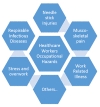Exploratory Study on Occupational Health Hazards among Health Care Workers in the Philippines
- PMID: 30835385
- PMCID: PMC6748249
- DOI: 10.29024/aogh.2316
Exploratory Study on Occupational Health Hazards among Health Care Workers in the Philippines
Abstract
Background and purpose: Healthcare workers are prone to occupational hazards. The study aims to identify the occupational health hazards among healthcare workers in the Philippines and its essential relevant developmental framework. This article evolved on the responses of participants on how they can improve strategies and barriers for healthcare workers to comply with Occupational Health and Safety (OSH).
Methods: A qualitative study design in which 15 healthcare workers from nurses (4), pharmacists (3), medical technologies (4) and medical doctors (4) participated: two focus group of three to four participants each and eight in-depth interviews. The thematic sessions were identified, including occupational health and safety policy implementations, hazards experiences, barriers, and strategies for quality improvement for OSH. Focus groups and interviews using transcript-based analysis were identified relating to emerging themes on the challenges they had experienced while accessing provisions of OSH in their workplace.
Results: Majority of the participants revealed the existence of policy on Occupational Health and Safety (provisions, guidelines and regulations on OHS from the government) and mentioned that there were limited OHS officers to supervise the healthcare workers in their workplace. Some have limited accessibility to the requirements of the implementation of OHS (free facemasks, gloves, disinfectants, machines, OSH staff, etc.) among healthcare workers, while the workload of the staff in the implementation of OHS in the workplace gradually increased. The results indicated that the respondents were knowledgeable in the implementation of OHS in the workplace, and that there was no existing ASEAN framework on the protection and promotion of the rights of healthcare workers in their workplace. Facilities need to improve health assessment, and to ensure constant evaluation of the existing laws for healthcare workers (quality assurance of existing policies) in their working areas. Direct access to OSH officers, occupational hazards education, emergency contact etc. must be improved. Adherence must be strengthened to fully comply with the OHS standards.
Conclusion: The researchers inferred that issues and concerns regarding compliance on provisions of occupational health and safety among health care workers must be properly addressed through immediate monitoring and reevaluation of personnel in terms of their knowledge and practices in OHS. Barriers and challenges have been identified in the study that can lead to improved compliance among healthcare workers in regards to OHS.
© 2018 The Author(s). This is an open-access article distributed under the terms of the Creative Commons Attribution 4.0 International License (CC-BY 4.0), which permits unrestricted use, distribution, and reproduction in any medium, provided the original author and source are credited. See http://creativecommons.org/licenses/by/4.0/.
Conflict of interest statement
The authors have no competing interests to declare.
Figures
Similar articles
-
Needs assessment regarding occupational health and safety interventions among textile workers: A qualitative case study in Karachi, Pakistan.J Pak Med Assoc. 2019 Jan;69(1):87-93. J Pak Med Assoc. 2019. PMID: 30623919
-
Using the behavior change wheel to identify barriers to and potential solutions for primary care clinical guideline use in four provinces in South Africa.BMC Health Serv Res. 2018 Dec 14;18(1):965. doi: 10.1186/s12913-018-3778-2. BMC Health Serv Res. 2018. PMID: 30547793 Free PMC article.
-
Occupational Safety and Health and Healthy Housing: A Review of Opportunities and Challenges.J Public Health Manag Pract. 2017 Nov/Dec;23(6):e36-e45. doi: 10.1097/PHH.0000000000000633. J Public Health Manag Pract. 2017. PMID: 28692612
-
Occupational health in the Philippines.Occup Med. 2002 Jul-Sep;17(3):455-68, v. Occup Med. 2002. PMID: 12028954 Review.
-
Systematic literature review on the effects of occupational safety and health (OSH) interventions at the workplace.Scand J Work Environ Health. 2019 Mar 1;45(2):103-113. doi: 10.5271/sjweh.3775. Epub 2018 Oct 29. Scand J Work Environ Health. 2019. PMID: 30370910
Cited by
-
Promoting Healthy Behaviors in Older Adults to Optimize Health-Promoting Lifestyle: An Intervention Study.Int J Environ Res Public Health. 2023 Jan 16;20(2):1628. doi: 10.3390/ijerph20021628. Int J Environ Res Public Health. 2023. PMID: 36674395 Free PMC article.
-
Occupational Health Hazards and Control Measures in Government Hospitals: A Cross-Sectional Survey of Nurses' and Nurse Managers' Perspectives.J Nurs Manag. 2025 Mar 24;2025:6657959. doi: 10.1155/jonm/6657959. eCollection 2025. J Nurs Manag. 2025. PMID: 40223895 Free PMC article.
-
The reality of occupational harm incurred by Japanese home health care nurses, the hazardous situations they face, and protective measures: a cross-sectional study.J Occup Health. 2024 Jan 4;66(1):uiad010. doi: 10.1093/joccuh/uiad010. J Occup Health. 2024. PMID: 38258941 Free PMC article.
-
Prevalence of Work-Related Health Hazard and Associated Factors among Health Workers in Public Health Institutions of Gambella Town, Western Ethiopia: Cross-Sectional Survey.J Environ Public Health. 2022 Aug 29;2022:6224280. doi: 10.1155/2022/6224280. eCollection 2022. J Environ Public Health. 2022. PMID: 36072494 Free PMC article.
References
-
- World Health Organization. Patient Safety. Guidelines on Hand Hygiene in Health Care; 2009. http://whqlibdoc.who.int/publications/2009/-9789241597906_eng.pdf. Accessed December 8, 2017.
-
- Department of Health. National Center for Health Facility Development, Philippine Hospital Infection Control Society (PHICS), Inc. Manila; 2009. http://www.doh.gov.ph/node/10061. Accessed December 1, 2017.
-
- Borg M. Prevention and control of healthcare associated infections within developing countries. International Journal of Infection Control. 2010; 6(1): 16–23. [Pubmed]. DOI: 10.3396/ijic.v6i1.001.10 - DOI
MeSH terms
LinkOut - more resources
Full Text Sources



